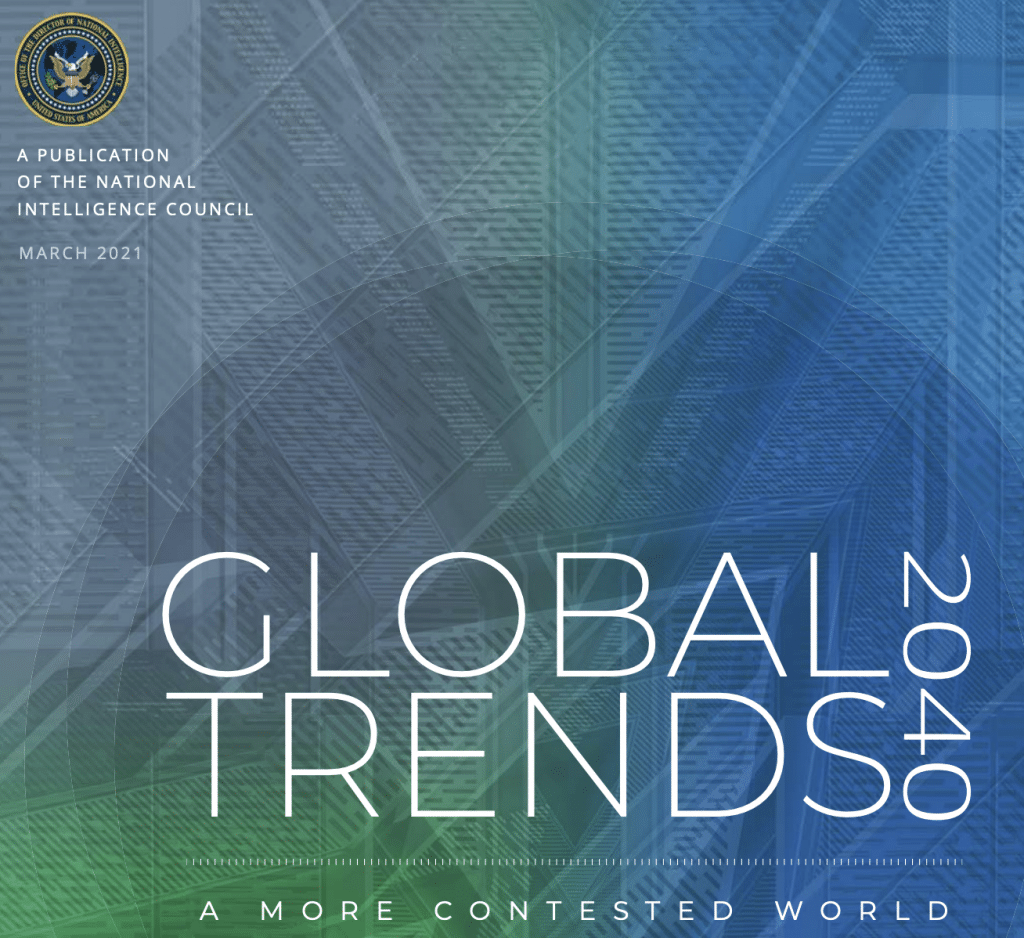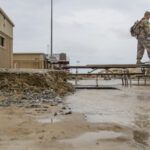An intelligence forecast and the Doomsday Clock coincide. For better or worse.
By John Mecklin | April 8, 2021

The National Intelligence Council released a new and grim report this week that made me immediately wonder, “Where have I seen this before?”
“Global Trends: A More Contested World” is the latest in a series of reports that the council, part of the US Office of the Director of National Intelligence, has issued every four years since 1997. In it, the council’s Strategic Futures Group “assesses the key trends and uncertainties that will shape the strategic environment for the United States during the next two decades.”
The trends are unsettling, to say the least. Just consider the first two sentences of the report’s introduction: “During the past year, the COVID-19 pandemic has reminded the world of its fragility and demonstrated the inherent risks of high levels of interdependence. In coming years and decades, the world will face more intense and cascading global challenges ranging from disease to climate change to the disruptions from new technologies and financial crises.”
For those without the time to read the report’s 156 pages, The Washington Post offers a first-rate summarization that includes these two eye-opening paragraphs:
Looking over the time horizon, [the report] finds a world unsettled by the coronavirus pandemic, the ravages of climate change — which will propel mass migration — and a widening gap between what people demand from their leaders and what they can actually deliver.
The intelligence community has long warned policymakers and the public that pandemic disease could profoundly reshape global politics and US national security. The authors of the report, which does not represent official US policy, describe the pandemic as a preview of crises to come. It has been a globally destabilizing event — the council called it “the most significant, singular global disruption since World War II” — that “has reminded the world of its fragility” and “shaken long-held assumptions” about how well governments and institutions could respond to a catastrophe.
Avid Bulletin readers may notice (as I did) a certain analytical similarity between the “Global Trends” report and the most recent Doomsday Clock statement, authored by the our Science and Security Board. Both documents note, for instance, that the COVID-19 pandemic revealed a worrisome inability of governments around the world to respond to a wide variety of major threats, including climate change. “The pandemic revealed just how unprepared and unwilling countries and the international system are to handle global emergencies properly,” the Clock statement asserts. “In this time of genuine crisis, governments too often abdicated responsibility, ignored scientific advice, did not cooperate or communicate effectively, and consequently failed to protect the health and welfare of their citizens.”
“Global Trends” includes five scenarios that describe what the world might look like in 20 years (with the appropriate caveat that the future cannot actually be predicted, even by intelligence professionals). Three scenarios are unhappy in different ways, ranging from the general grimness of “A World Adrift” to a more modulated semi-dystopia, “Separate Silos,” in which wealthy countries do reasonably well, some developing countries become failed states, and “[g]lobal problems, notably climate change, are spottily addressed, if at all.”
In two other scenarios, the world eventually comes to deal in some way with some of the largest global threats.
The description of one of those scenarios, “Tragedy and Mobilization,” begins this way:
In the early 2030s, the world was in the midst of a global catastrophe. Rising ocean temperatures and acidity devastated major fisheries already stressed by years of overfishing. At the same time, changes in precipitation patterns depressed harvests in key grain producing areas around the world, driving up food prices, triggering widespread hoarding, and disrupting the distribution of food supplies, leading to global famine. A wave of unrest spread across the globe, protesting governments’ inability to meet basic human needs and bringing down leaders and regimes. In one of many incidents in the Western world, thousands of people were killed in three days of violence in Philadelphia triggered by social media rumors about bread shortages.
The ongoing famines catalyzed a global movement that advocated bold systemic change to address environmental problems.
In the other scenario, titled “Renaissance of Democracies,” in 2040 “the world is in the midst of a resurgence of open democracies led by the United States and its allies. Rapid technological advancements fostered by public-private partnerships in the United States and other democratic societies are transforming the global economy, raising incomes, and improving the quality of life for millions around the globe.”
The American exceptionalism of the Renaissance scenario aside, the overall “Global Trends” message echoes with rather remarkable fidelity what the Science and Security Board wrote in January: “Given the pandemic experience, no one can reasonably say he or she was not warned…. It is time for all to take the actions needed to—quite literally—save the world.”
Together, we make the world safer.
The Bulletin elevates expert voices above the noise. But as an independent nonprofit organization, our operations depend on the support of readers like you. Help us continue to deliver quality journalism that holds leaders accountable. Your support of our work at any level is important. In return, we promise our coverage will be understandable, influential, vigilant, solution-oriented, and fair-minded. Together we can make a difference.















